









|
|
The Original Farm and Owners of Eby's Pequea Farm
Mary Ferree originally settled this land in 1712 from a grant given
to her from William Penn. The grant included 2,300 acres. Our farm was
part of that tract. After her death, her children divided the land. Her
son, Daniel Ferree, owned this land until 1752; then it was sold to a
Scotch Irishman, Matthew McClung. The McClung family built our old stone
barn in the late 1750s. The barn is unique, a double-decker. The first
floor is the stable; the second floor is the haymow; and the third floor
is where the wheat was brought in for threshing. The gram was dropped
through the holes in the floor to the granary below. It has an 8-ft.
overhang forebay.
The McClungs lived in a small, stone house, which had a spring in the
bottom. Matthew McClung sold the farm, which also included a gristmill
and a tenant house, to his son, Hugh, in 1798. In 1814. My great, great,
great grandfather, Jacob Frantz, moved here from northern Lancaster
County and bought the farm of 201 acres for $40,240 in gold and silver
from Hugh McClung. He built the main part of our 16-room farmhouse that
year. The house has three corner cupboards, two of which have butterfly
shelves and spoon holders. One is made from walnut wood and panels are birle walnut.
The rooms on the south side or front of the house have carved
woodwork.
The Frantz Family
Jacob Frantz had a son, Jacob Jr., who farmed the farm and kept a diary
of day-to-day activities on the farm fro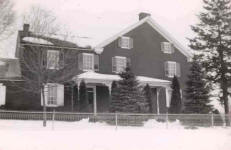 m 1835 to 1845, when he took 30
acres off this farm and built another homestead a quarter of a mile away. He kept
his diary plus many other records until his death in 1870. Jacob Frantz
Sr. died in 1842. We have his will, which states that his son Henry was to
purchase the farm for $9,940. He farmed here from 1845 to 1849. In 1849,
he bought a farm west of Baltimore, at which time Jacob Frantz Sr.'s
daughter Anna, married to Sem Eby, moved to this farm on January 1, 1849.
By this time, the property was down to 127 acres. Sem lived here from
1849 to 1881. In 1870, he took off 60 acres to the north and built a
homestead for his son, Amos. We have record of his expense, which was
$5,000. He also built a larger piece onto the original Frantz dwelling
toward the east, which is now our kitchen. m 1835 to 1845, when he took 30
acres off this farm and built another homestead a quarter of a mile away. He kept
his diary plus many other records until his death in 1870. Jacob Frantz
Sr. died in 1842. We have his will, which states that his son Henry was to
purchase the farm for $9,940. He farmed here from 1845 to 1849. In 1849,
he bought a farm west of Baltimore, at which time Jacob Frantz Sr.'s
daughter Anna, married to Sem Eby, moved to this farm on January 1, 1849.
By this time, the property was down to 127 acres. Sem lived here from
1849 to 1881. In 1870, he took off 60 acres to the north and built a
homestead for his son, Amos. We have record of his expense, which was
$5,000. He also built a larger piece onto the original Frantz dwelling
toward the east, which is now our kitchen.
The Eby Family
In 1880, John Eby, the youngest of Sem's 11 children, bought the
farm for $11,000. The farm then contained 67 acres. During the 31 years
he owned it, he bought two neighboring farms and added 13 acres, making
it 80, which it still is today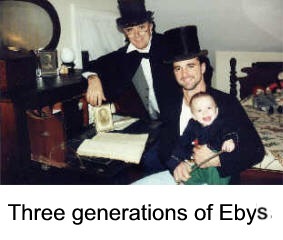 . In 1921, Ira Eby bought the farm for
$18,000. He owned it until 1948, when Clair Eby bought it for $25,000. He
owned it until 1976. I started farming in 1967 and
built the new 52 stall dairy barn in 1972. Joyce and I opened our home to overnight guests in 1970, so families could
experience life on the farm. After 32 years of farming, we moved
across the field to a new home. We continue to enjoy guests here as
well. Our son, Michael, took over the farm in 1999. Mike and Lynette Eby became the sixth generation to farm the land. The farm has been in
the family for 184 years and in the Eby name 150 years. Mike and Lynette
feel this is a privilege from the Lord to be able to continue the
wonderful and fulfilling life on the farm. We've entertained people from
across the United States and many foreign countries. . In 1921, Ira Eby bought the farm for
$18,000. He owned it until 1948, when Clair Eby bought it for $25,000. He
owned it until 1976. I started farming in 1967 and
built the new 52 stall dairy barn in 1972. Joyce and I opened our home to overnight guests in 1970, so families could
experience life on the farm. After 32 years of farming, we moved
across the field to a new home. We continue to enjoy guests here as
well. Our son, Michael, took over the farm in 1999. Mike and Lynette Eby became the sixth generation to farm the land. The farm has been in
the family for 184 years and in the Eby name 150 years. Mike and Lynette
feel this is a privilege from the Lord to be able to continue the
wonderful and fulfilling life on the farm. We've entertained people from
across the United States and many foreign countries.
Friendship burns bright
Intelligencer Journal (Lancaster, PA) Publication Date: October 20,
2005
By: Brett Lovelace Etched in the stone walls of the Leacock Township
barn destroyed early Monday by an
 arsonist
are the names of men who spent their lives working the surrounding land.
The names have been there nearly as long as the centuries-old barn,
owned by Melvin Eby. "Some people told us to bulldoze what the fire
spared," Eby said. "My great-great-great-grandfather left his name
on that wall in 1869. "That's something that can't be replaced." Our
family has owned the farm at 459 Queen Road for 205 years. The
three-story barn is 260 years old. arsonist
are the names of men who spent their lives working the surrounding land.
The names have been there nearly as long as the centuries-old barn,
owned by Melvin Eby. "Some people told us to bulldoze what the fire
spared," Eby said. "My great-great-great-grandfather left his name
on that wall in 1869. "That's something that can't be replaced." Our
family has owned the farm at 459 Queen Road for 205 years. The
three-story barn is 260 years old.
Since it was gutted by fire, hundreds of volunteers have stopped by
to help the Ebys rebuild the barn, which housed 30 cows, about 2,000
bales of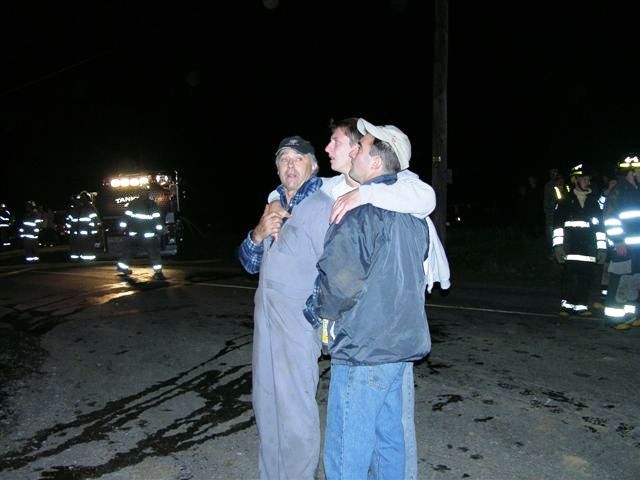 hay and farm equipment. "For the past two days, we've had 40 to 50
people here," Melvin Eby's son, Jon Michael Eby, said. "It's not
organized, but it's perfect the way it just happens. They show up at
dawn and leave at dusk." The first two days were spent clearing the
charred planks, burned hay and damaged concrete floor. A crew washed
smoke stains off the stone walls Wednesday. Tarpaulins were hung across
the names inscribed in the rock to preserve the writings. Some of the
wood beams will be replaced with steel, and new concrete will be poured.
The barn raising is expected to begin next week.
hay and farm equipment. "For the past two days, we've had 40 to 50
people here," Melvin Eby's son, Jon Michael Eby, said. "It's not
organized, but it's perfect the way it just happens. They show up at
dawn and leave at dusk." The first two days were spent clearing the
charred planks, burned hay and damaged concrete floor. A crew washed
smoke stains off the stone walls Wednesday. Tarpaulins were hung across
the names inscribed in the rock to preserve the writings. Some of the
wood beams will be replaced with steel, and new concrete will be poured.
The barn raising is expected to begin next week.
A majority of the volunteers at the farm south of Intercourse are
Amish. Some remember helping to rebuild barns across e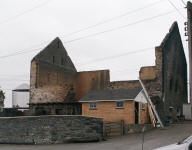 astern
Lancaster County after arsonists torched seven barns in 2001. Although
the Ebys aren't Plain, a traditional Amish barn raising is being
planned. Donald B. Kraybill, a professor at Elizabethtown College and an
expert on Amish culture, said Amish people raising a barn for an English
family is unusual. "Although the religious obligation is not as strong,
the Amish are taught to help people in need," Kraybill said. "Everyone
freely donates their time because their house or shop may be next."
Kraybill wrote in his 1989 book "The Riddle of Amish Culture" that barn
raising is a long-standing tradition among Am astern
Lancaster County after arsonists torched seven barns in 2001. Although
the Ebys aren't Plain, a traditional Amish barn raising is being
planned. Donald B. Kraybill, a professor at Elizabethtown College and an
expert on Amish culture, said Amish people raising a barn for an English
family is unusual. "Although the religious obligation is not as strong,
the Amish are taught to help people in need," Kraybill said. "Everyone
freely donates their time because their house or shop may be next."
Kraybill wrote in his 1989 book "The Riddle of Amish Culture" that barn
raising is a long-standing tradition among Am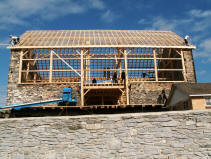 ish
people. "This simple but powerful tradition is embedded in the cultural
capital — the values of mutual obligation, duty and trust that are
simply taken for granted in Amish society." In the book, Kraybill
relates an Amishman's description of the barn-raising process as smooth,
seamless and almost effortless. "There isn't a crane poking its long
boom skyward, hook dangling. There are no white-hatted foremen dashing
about with squawking radios. "Now watch as, just as for the last 500
years, a forty-six-foot-long line of straw-hatted men, facing east, bend
down. Forty-six feet of rear ends face westward, with all hands on the
top timber of the assembled frame. "All are ready to push it skyward.
The moment is dramatic, everyone is quiet as several late comers rush up
the barn hill to help. With some minor grunts the ponderous frame moves
up, hands outstretched." ish
people. "This simple but powerful tradition is embedded in the cultural
capital — the values of mutual obligation, duty and trust that are
simply taken for granted in Amish society." In the book, Kraybill
relates an Amishman's description of the barn-raising process as smooth,
seamless and almost effortless. "There isn't a crane poking its long
boom skyward, hook dangling. There are no white-hatted foremen dashing
about with squawking radios. "Now watch as, just as for the last 500
years, a forty-six-foot-long line of straw-hatted men, facing east, bend
down. Forty-six feet of rear ends face westward, with all hands on the
top timber of the assembled frame. "All are ready to push it skyward.
The moment is dramatic, everyone is quiet as several late comers rush up
the barn hill to help. With some minor grunts the ponderous frame moves
up, hands outstretched."
Jon Michael Eby said he's looking forward to completing the
reconstruction. He
said he longs for the routine of milking cows and teaching his
5-year-old son, Jackson, about the farm. "I was alone (Wednesday) in the
milking barn for the first time since the fire," he said. "I had a good
cry, and it was good to get it all out." For him, images of the fire are
strongest at night. He was asleep in a nearby brick farmhouse when the
fire was detected shortly after midnight Monday. "The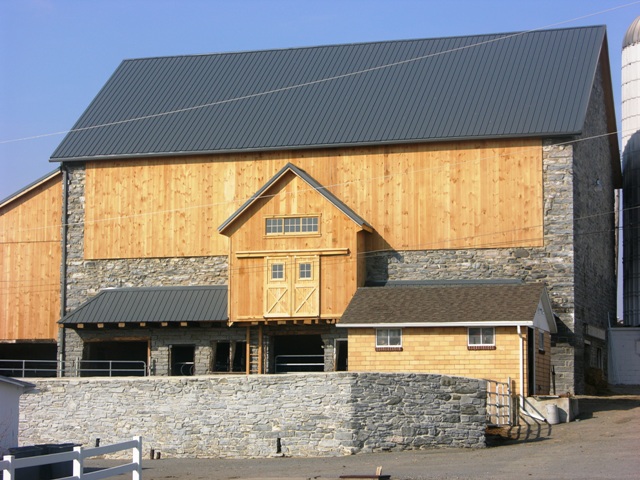 first night after the fire, my wife and I laid down in our bed to
sleep," he said. "Within three minutes, I leaned over and told my wife I
couldn't sleep because all I saw was the orange glow of the fire. "We
took out our pillows, moved to our child's room and slept there." Jon
Michael and Melvin Eby have relied on one another to cope while making
decisions about how the new barn will look. "We have to make decisions
in two hours, not two days," Jon Michael Eby said. "I couldn't do it
without the help of my dad."
first night after the fire, my wife and I laid down in our bed to
sleep," he said. "Within three minutes, I leaned over and told my wife I
couldn't sleep because all I saw was the orange glow of the fire. "We
took out our pillows, moved to our child's room and slept there." Jon
Michael and Melvin Eby have relied on one another to cope while making
decisions about how the new barn will look. "We have to make decisions
in two hours, not two days," Jon Michael Eby said. "I couldn't do it
without the help of my dad." For additional pictures of the barn
raising, visit the
photo gallery.
|

